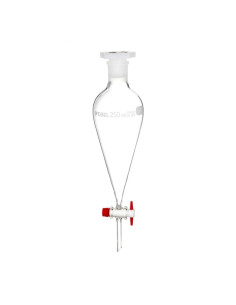DROPPING AND SEPARATING FUNNELS
DROPPING FUNNEL WITH SCALE
DROPPING FUNNEL WITHOUT SCALE
DROPPING FUNNEL, WITH BOTTOM JOINT, WITH SCALE
DROPPING FUNNEL, WITH BOTTOM JOINT, WITHOUT SCALE
What are Dropping and Separating Funnels?
A separating funnel, also known as a decanting funnel, is an essential laboratory tool used to separate immiscible liquids, such as water and oil, in a controlled manner. This funnel typically has a conical or pear-shaped design, is made of glass or plastic, and features a stopcock at the bottom. The separation process is carried out by controlling the release of the lower phase through the stopcock, allowing the liquids to separate without mixing. This type of funnel is indispensable in extraction and separation procedures, especially in chemistry and biology, as it enables precise handling of substances that do not mix.
What is a Dropping Funnel?
A dropping funnel is a type of funnel designed to facilitate the pouring of liquids or solids into narrow-necked containers, such as flasks or jars, without the risk of spillage. Its structure typically features a wide opening at the top and a narrow outlet, which allows for controlled pouring of substances. Dropping funnels are widely used in laboratories to add reagents or samples during experiments, avoiding waste and contamination of samples.
What is the difference between a Separating Funnel and a Dropping Funnel?
The main difference between a separating funnel and a dropping funnel lies in their function and design:
Function:
- Separating funnel: Designed to separate immiscible liquids (e.g., water and oil). It includes a stopcock to control the flow of one liquid, retaining the other in the funnel.
- Dropping funnel: Used to transfer liquids or solids into narrow-necked containers, facilitating the process without spills. It is not designed for separating liquids, only for transferring them.
Design:
- Separating funnel: Has a pear-shaped or inverted cone design with a stopcock at the bottom, allowing controlled flow of liquids.
- Dropping funnel: Generally a conical funnel without a stopcock, featuring a narrow neck at the bottom for channeling liquids or solids, and a wide mouth at the top for easier pouring.
In summary, while the separating funnel is designed for controlled liquid separation, the dropping funnel is used to transfer substances between containers without waste.
Types of Separating Funnels
Various types of separating funnels are available on the market, categorized by material and capacity to suit different laboratory applications:
- Glass separating funnels: Ideal for processes requiring high chemical resistance and precision.
- Plastic separating funnels: More resistant to impact, making them a practical and economical option.
- Capacity-specific separating funnels: Available in a range of sizes, from 50 ml to several liters, to meet different workload requirements.
Advantages of Using Separating Funnels in the Laboratory
Separating funnels are fundamental in laboratories due to their unique benefits in liquid separation:
- Precision in separation: Their design allows for the exact separation of immiscible liquids. The adjustable stopcock ensures gradual control, allowing each phase to be transferred without cross-contamination, which is critical in analyses and experiments where purity is essential.
- Safety in handling substances: The funnel's structure reduces the risk of direct contact with potentially hazardous substances. The regulated outflow minimizes the chance of accidental spills and exposure, improving operator safety.
- Versatility in applications: This instrument is indispensable across multiple sectors, such as organic chemistry, where solvent separation is common, or in biology and pharmacy for the extraction of active principles. Its versatility makes it an essential tool for extraction, purification, and separation procedures.
Why Choose Pobel's Separating Funnels?
Pobel offers high-quality separating funnels designed specifically to meet the needs of laboratories prioritizing precision and durability:
- High-quality materials: Pobel's funnels are made from durable borosilicate glass, offering excellent stability against corrosive chemicals and variable temperatures. This material ensures a long lifespan even with frequent use.
- Variety of options: Pobel's range includes a variety of capacities, from small models for reduced samples to large funnels for higher volumes. This allows users to choose the perfect funnel for their specific application needs.
- Commitment to precision: Designed with a high-precision stopcock and ergonomic body, Pobel's funnels ensure comfortable handling and exact control of the flow. This attention to detail contributes to consistent and reliable results in every separation process.
Care and Maintenance of Separating Funnels
Proper maintenance of separating funnels is essential to ensure their durability and performance in the laboratory. Below are some basic care guidelines:
- Cleaning after each use: It is crucial to clean the funnel after each use to prevent residue buildup and contamination in future separations. For glass funnels, use mild detergents and distilled water. Plastic funnels should be cleaned with products that do not damage their surface.
- Stopcock inspection: The stopcock is a key component of the separating funnel. Regularly check that it is free of obstructions and operates smoothly. To keep it in good condition, lubricate it with specific products for glass or plastic, depending on the funnel's material.
- Complete drying: After cleaning, ensure the funnel is completely dry to prevent moisture from causing damage or altering results in future uses. Glass funnels can be dried with compressed air or a lint-free cloth, while plastic funnels should be dried carefully to avoid deformation.
- Safe storage: Store the funnel in a clean and safe place, preferably in a position where it is not exposed to impacts or falls. Glass funnels are particularly sensitive and require careful storage to prevent breakage.
By following these care tips, Pobel's separating funnels maintain their functionality and extend their lifespan, ensuring precise results with every use.


















